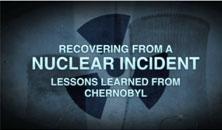Recovering from a Nuclear Incident – Lessons Learned from Chernobyl
 This series of 12 video segments examines some of the lessons learned from the Chernobyl nuclear power plant accident. The segments include the unique perspective of two survivors of Chernobyl. The videos offer information about radiation and how EPA is preparing to respond to a large-scale radiological or nuclear incident in the United States.
This series of 12 video segments examines some of the lessons learned from the Chernobyl nuclear power plant accident. The segments include the unique perspective of two survivors of Chernobyl. The videos offer information about radiation and how EPA is preparing to respond to a large-scale radiological or nuclear incident in the United States.
Part 1: Introduction to Lessons Learned
The United States Environmental Protection Agency and other federal agencies are constantly preparing for disastrous events, including event involving nuclear and radiological materials. EPA examines the events following the 1986 Chernobyl catastrophe in order to better prepare itself for equally devastating nuclear accidents or acts of terrorism.
Part 2: Radiation and Radioactivity
This segment discusses general radiation topics including:
- ionizing and non-ionizing radiation,
- background radiation,
- the four major types of ionizing radiation,
- radiation dangers, and
- how the public can protect itself in the event of a disaster.
Part 3: Types of Radiological Incidents
There are four major nuclear scenarios for which EPA is preparing. This segment discusses:
- a radiological dispersal device (RDD) (aka as dirty bomb),
- a radiological exposure device (RED),
- a terrorist targeted nuclear power plant, and
- the detonation of an improvised nuclear device (IND).
This segment also discusses the different effects, as well as the different methods for reducing the risks, in each of these scenarios.
Part 4: The Initial Response
Following any of the prospective nuclear disaster scenarios, there will be a period of chaos. The success of the recovery from the disaster depends strongly on the initial response of the local, state and federal agencies. This segment outlines the initial response of the government to the Chernobyl disaster in hopes of identifying critical information pertinent to future responses.
Part 5: Learning from the Chernobyl Recovery
This segment documents some of the recovery efforts by the local and Russian governments following the Chernobyl disaster. Two survivors of the disaster, Larisa Leonova (an early responder) and Vira Yakusha (an expectant mother living in Kiev), discuss the early recovery efforts after the nuclear power plant accident that contaminated 10,000 square miles of land. They discuss how they protected themselves and their families.
Part 6: Reducing the Risk
Once the immediate crisis at Chernobyl had been contained, efforts were redirected towards mitigating the effects of the disaster. This segment documents several methods used to reduce the dose from the fallout to the general public. This segment explores what, where and how to decontaminate following a large nuclear disaster.
Part 7: Managing the Food Supply
After the initial crisis is under control, the efforts turn to safeguarding the food supply. This segment discusses those measures that were used in Chernobyl to mitigate the risk to the food supply. Vira Yakusha discusses their efforts to reduce her own exposure and especially that of her infant daughter. Food supplies were monitored and livestock management was adjusted to reduce the dose from the food supply. Soil was treated and some areas were quarantined.
Part 8: Coping with Health Concerns
Health problems were a major concern among those affected by the accident. Vira Yakusha, a young mother, discusses the decisions she made in order to help ensure the safety of her young daughter who was born four months after the Chernobyl accident.
Part 9: The Importance of Information
As with many crises, much of the difficulty early in the crisis is due to lack of available, credible information. Larisa Leonova and Vira Yakusha describe what information was available following the Chernobyl disaster, how it was disseminated, and how it affected their personal decisions. In the U.S. there are plans to ensure greater openness and rapid dissemination of the appropriate precautions to take.
Part 10: Being Prepared
What is the U.S. government doing to prepare for a nuclear/radiological incident? There are high level preparations being made and exercised at all levels of government to ensure an effective, measured, and timely coordinated response. This segment discusses how the government’s preparations and how individuals can prepare themselves to respond to an incident.
Part 11: Conclusion
We can recover safely. The U.S. continues to prepare for such an incident. The U.S., as well as other countries, can survive and flourish following a nuclear catastrophe. However, it may require a long period of time to fully recover from an incident. EPA explores the catastrophe in Chernobyl to provide information to the public to educate themselves on the risks and the ways they can be reduced.
